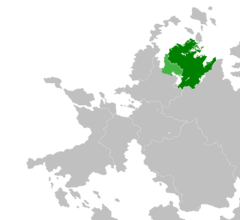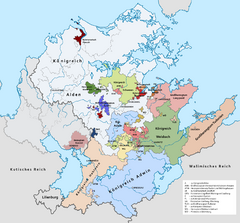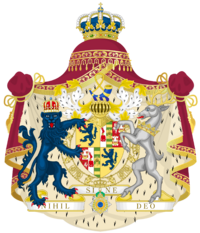Mascyllary Kingdom
Mascyllary Kingdom Maskillisches Königreich (Hesurian) | |
|---|---|
| 1793–1924 | |
Motto: Vereint in Blut und Ehre "United in blood and honour" Nihil sine Deo "Nothing without God" (Cambran) | |
 The Mascyllary Kingdom on the eve of the Great War in green, territories lost after 1841 in light green | |
 | |
| Capital | Langquaid (1793-94) Königsreh (1794-) |
| Common languages | Official: Hesurian Unofficial: Cuthish Valimian Temarian Falian |
| Religion | Semitarism |
| Demonym(s) | Mascyllary |
| Government | Federal parliamentary semi-constitutional monarchy |
| King | |
• 1793–1827 (first) | Lukas I |
• 1892–1923 (last) | Ludwig I |
| Prime Minister | |
• 1793–1835 (first) | Wilhelm Stenreck |
• 1922–1923 (last) | Erwin Martinsen |
| Legislature | Imperial Diet |
| Imperial Diet | |
| Federal Council | |
| Historical era | 1793–1923 |
| 23 May 1793 | |
• Constitution adopted | 17 April 1796 |
| 8 September 1910 | |
| 10 March 1917 | |
| 13 May 1923 | |
| 2 June 1923 | |
| 26 January 1924 | |
| Population | |
• 1800 | 6,800,000 |
• 1900 | 21,570,000 |
• 1909 | 23,720,000 |
• 1920 | 26,220,000 |
| Currency | Mascyllary gold mark (1793–1910) Mascyllary Pappemark (1910–1918) Mascyllary silver mark (1918–1923) |
| Today part of | |
The Mascyllary Kingdom (Hesurian: Maskillisches Königreich), also inofficially known as the Kingdom of Mascylla (Hesurian: Königreich Maskillien), was the Mascyllary nation state that existed from the unification of Mascylla in 1793 until the abdication and execution of King Ludwig I in 1923. The Mascyllary Kingdom was composed of 31 states, most of them had been ruled by a royal family. These included five kingdoms, six grand duchies, four duchies, fourteen principalities, and two independent cities. The unification and establishment of Mascylla was belatedly concluded with the Treaty of Langquaid signed on 18 May 1793 to end the fighting of the War of the Five Kings, the subsequent proclamation of Aldian king Lukas I as King of Mascylla in Langquaid on 23 May, and the adoption of the Constitution of Mascylla on 17 April 1796. On the basis of the hegemony of the House of Ahnern over Mascylla as a whole and the exclusion of Adwhin from supranational power, the Mascyllary Kingdom was the first Mascyllary nation state in history.
The kingdom saw a major and gradual transformation of society and economy owed to the Industrial Revolution, while it socially and structually began to reform itself from an agrarian state to an industrial nation, with significant service, banking and manufacturing sectors and a steadily growing economy (colloquially dubbed the Gründerjahre). The increasing emancipation of the growing middle class of entrepeneurs and politically active citizens prompted social reforms such as increased global trading, suffrage and socialism as political directive of the rising worker class. Structural basis of these developments include a rapid population growth, large migration and urbanisation.
The development of domestic and foreign policy was dominated by the fallout of the Second Cutho-Mascyllary War of 1839-41 and worsening enmity to Cuthland. Succeeding prime ministers and kings, most notably King Ludwig I, designed an intricate international network of alliances with Lavaria and later Albeinland, similar to Wilhelm Stenreck's original foreign policy in the 1830s abolished by the more ambitious Lukas II, which sought to combat the Central Alliance's powers of Cuthland and Dulebia in Berea. While the alliances were supposed to ensure peace among major powers, Ludwig I intensified the role of Mascylla as a global and imperialist power, vying to regain lost territories from Cuthland as ravanchism and expand its colonial empire in overseas. International conflicts of interest arose quickly and laid the foundations of the later Great War.


